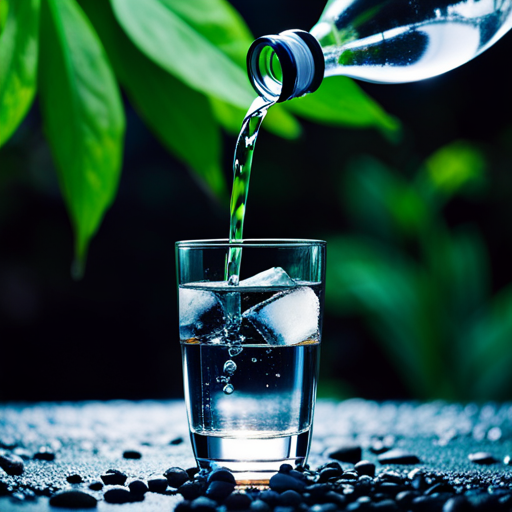Are you concerned about the amount of fluoride in your drinking water? While fluoride has been added to public drinking water in the US for decades to combat tooth decay, some countries have started to reduce or eliminate it due to concerns about overexposure and safety.
If you’re looking to reduce your fluoride intake, there are a few options available to you. One of the most effective ways to remove fluoride from drinking water is through reverse osmosis or distillation systems. While PUR filters can reduce fluoride levels by up to 50%, they cannot completely remove it.
In this article, we’ll explore how reverse osmosis and distillation work, why they may be a better option for those concerned about fluoride, and what you should know before investing in one of these systems. So, say goodbye to fluoride and hello to cleaner, safer drinking water.
Key Takeaways
– Fluoride has been added to water for decades to fight tooth decay, but concerns about its safety and necessity exist.
– PUR filters can reduce but not completely remove fluoride from drinking water, with a maximum reduction of up to 50%.
– Reverse osmosis or distillation systems are the most effective ways to remove fluoride from drinking water.
– Fluoride overexposure can cause various health hazards and ailments, including increased bone fragility, reduced joint mobility, thyroid disorder, reproductive harm, neurological damage, and possible intellectual and behavioral issues in children.
Fluoride in Drinking Water
You already know that fluoride is added to water to fight tooth decay, but did you know that fluoride toxicity can cause various health hazards and ailments? Some medical and scientific communities express concerns about fluoride’s safety and necessity, and some countries have reduced or eliminated fluoride from public drinking water.
While PUR filters can reduce up to 50% of fluoride, they can’t completely remove it from drinking water. If you want to enjoy fluoride-free water, the best ways to do so are through reverse osmosis or distillation systems. Bottled water brands such as Aquafina, Ic Mountain, or Dasani also contain less fluoride than fluoridated municipal water.
So, if you’re looking for fluoride-free water options, you have several choices to choose from.
PUR Filters and Fluoride Reduction
Using PUR filters may not completely eliminate fluoride from your drinking water, but it can reduce up to 50% of it. PUR filters use NSA 42, NSA 53, or NSA 401 filters to improve the taste and smell of your water and trap major harmful elements.
However, fluoride is a much finer property and cannot be eliminated from water with a standard filtration system like PUR. While some fluoride may be trapped by PUR filters, much of this element will still make it through and be consumed.
Therefore, if you want to completely remove fluoride from your drinking water, you may need to consider other fluoride removal methods such as reverse osmosis or distillation systems. These methods are known to be more effective in removing fluoride from water.
Reverse Osmosis and Distillation Solutions
Consider other options for removing fluoride from your drinking water, such as specialized filtration systems or treatment methods. While PUR filters can reduce some fluoride levels, they cannot completely eliminate this element from your water. For a more effective solution, consider reverse osmosis or distillation systems that can remove up to 95% of fluoride, among other contaminants. These methods use different approaches to purify your water, and you can choose the one that best suits your needs and budget.
Water purification methods vary in their effectiveness, cost, and maintenance requirements. Here is a comparison table of reverse osmosis and distillation systems, two popular options for fluoride removal, along with their pros and cons and potential health effects of fluoride overexposure:
| Water purification method | Pros | Cons | Health effects of fluoride overexposure |
|---|---|---|---|
| Reverse osmosis | Removes up to 95% of fluoride and other contaminants, requires minimal maintenance, and leaves no residual taste or odor. | Can be expensive upfront and may waste water during the purification process. | Increased bone fragility, reduced joint mobility, thyroid disorder, reproductive harm, neurological damage, possible intellectual and behavioral issues in children. |
| Distillation | Removes up to 99% of fluoride and other contaminants, can be used for larger volumes of water, and requires minimal maintenance. | May require a longer purification time and may not remove some volatile organic compounds or bacteria. | Same as reverse osmosis. |
By choosing a specialized filtration system or treatment method, you can ensure that your drinking water is safe and healthy for you and your family. Consult with a water treatment professional to determine the best solution for your home and lifestyle.
Conclusion
So, you’ve learned about the potential risks of fluoride overexposure and how it’s commonly added to drinking water to combat tooth decay.
While PUR filters can reduce fluoride levels, they can’t completely remove it.
But don’t worry, there are solutions – reverse osmosis and distillation systems can effectively remove fluoride from your drinking water.
Reverse osmosis and distillation may seem like a bigger investment compared to a simple filter, but the long-term health benefits make it worth considering.
By removing fluoride from your drinking water, you’re taking a step towards reducing your risk of potential health problems and improving your overall well-being.
So, say goodbye to fluoride with a reverse osmosis or distillation system and enjoy the peace of mind that comes with knowing you’re making a healthy choice for you and your family.




